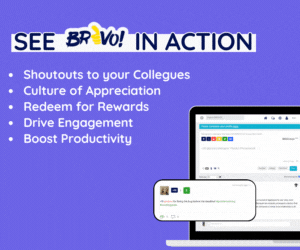
Virtual employee engagement is a notion that emphasizes employees’ active participation and emotional commitment to their jobs regardless of physical location. Virtual employee engagement platform is essential for boosting productivity in the modern workplace, creating a happy work environment, and attaining organizational goals. Employees who are engaged are more likely to go above and beyond the call of duty, show better levels of work satisfaction, and contribute to the success of the company as a whole.
There has been a considerable trend toward virtual work environments in recent years. Technology developments and the worldwide pandemic, which required remote work arrangements, have expedited this change. Numerous advantages come with working virtually, including more freedom, cost savings, and access to a worldwide labor pool. It does, however, also raise issues with employee engagement. In order to maintain employee engagement and connection in the absence of physical closeness and face-to-face encounters, firms must develop novel strategies.
In this blog post, we’ll talk about the value of employee engagement in modern workplaces with a particular emphasis on virtual work settings. We’ll talk about the difficulties of working remotely and the demand for efficient online tools for virtual employee engagement. Learn tactics, tools, and best practices for fostering high levels of participation in virtual environments and for establishing a successful workplace.
Understanding Virtual Employee Engagement Platforms and its Importance
Virtual employee engagement platforms are digital tools and software solutions designed to promote and enhance employee engagement in remote or virtual work environments. These platforms offer a virtual environment where staff members can connect, work together, and take part in numerous activities to keep them feeling connected and inspired.
In contrast to conventional office settings, virtual employee engagement solutions use technology to close the gap between the two locations and provide a virtual working environment. A variety of services are available from them, including virtual social spaces, tools for team collaboration, systems for incentives and recognition, learning and development resources, and virtual events. Through involvement and the promotion of a healthy workplace culture, these platforms seek to duplicate the advantages of in-person interactions in digital environments.
Statistics and Research on the Growing Adoption of Virtual Employee Engagement Platforms

- A Boston Consulting Group survey found that 75% of respondents felt like they had maintained or increased their productivity after going remote.
- Millennials lead the way among those who prefer fully remote work, with 44%, compared to 41% of Generation X, 40% of Gen Z, and 38% of boomers.
- According to a survey conducted by Gartner in 2021, 82% of company leaders plan to allow remote work in some form, even after the COVID-19 pandemic.
- Research by Gallup found that companies with highly engaged employees outperform their competitors by 147% in earnings per share.
- Increasing demand for a growing virtual workplace, enhancing employee and management communication, and expanding outsourcing activities are propelling the Employee engagement and feedback software market forward.
These statistics and research indicate how virtual employee engagement platforms are being more recognized as vital resources for promoting engagement, productivity, and organizational success in the changing workplace. To solve the challenges of remote work and make sure that employees are connected, motivated, and engaged in virtual environments, organizations are increasingly utilizing these platforms.
Various Types of Virtual Employee Engagement Platforms

Communication and Collaboration Platforms
These platforms focus on facilitating real-time communication and collaboration among remote teams. To facilitate smooth teamwork and communication, they provide services like video conferencing, instant messaging, document sharing, and project management tools.
Gamified Engagement Platforms
Platforms that are gamified include game-like aspects into the employee experience to boost motivation and engagement. To make job activities more dynamic, pleasant, and rewarding, they use elements like challenges, contests, awards, and leaderboards.
Learning and Development Platforms
These platforms place a strong emphasis on the professional development of its users in virtual settings. They provide access to resources for lifelong learning and professional growth, as well as e-learning modules, virtual training sessions, knowledge exchange platforms, and other services.
Recognition and Rewards Platforms
These tools emphasize recognizing and rewarding employees for their efforts and accomplishments. In order to foster a climate of appreciation and incentive, they offer means for peer-to-peer recognition, virtual badges, point systems, and performance monitoring.
The Power of Virtual Employee Engagement Platforms
Organizations can build a strong sense of belonging among remote employees, encouraging cooperation, collaboration, and a shared sense of purpose, by utilizing virtual employee engagement solutions. These platforms improve communication channels by fostering open and timely information sharing and by giving employees a way to give feedback and participate in decision-making. The strength of virtual employee engagement software resides in their capacity to overcome geographical barriers, forge deep bonds, and provide a sense of community and productive communication in distant work environments.
Creating a Sense of Belonging
The engagement and general contentment of remote workers depend on creating a sense of connection for them. Platforms for virtual employee engagement contribute significantly to the development of this feeling of community by offering chances for online team building and cooperation. These platforms include tools like digital social spaces, online chat rooms, and interactive team activities that foster collaboration among staff members who may be geographically separated.
Employees can establish personal bonds, increase trust, and solidify their feeling of loyalty to the group through virtual team-building exercises. Collaboration tools integrated into these platforms enable seamless teamwork, encouraging employees to work together on projects, share ideas, and feel like valued contributors to the team’s success.
Enhancing Communication and Feedback
For distant teams, effective communication is essential, and virtual employee engagement tools are crucial for enhancing channels of communication. These platforms provide a variety of communication tools including video conferencing, instant messaging, and virtual meeting spaces that facilitate in-person interactions in real-time. Remote workers can communicate with coworkers, managers, and cross-functional teams, promoting open communication and lowering obstacles.
Moreover, virtual employee engagement platforms often incorporate feedback mechanisms, such as surveys, polls, and suggestion boxes, allowing employees to provide their input and share their thoughts. This strengthens the organization’s feedback culture and guarantees that workers’ opinions are taken into account, especially in remote work settings.
Key Features of Virtual Employee Engagement Platforms

Gamification and incentives, social interaction and networking, performance monitoring and analytics, support for physical and mental health, AI-driven features, and integration with already-existing communication and collaboration tools are among the primary aspects of virtual employee engagement tools. These features work together to create a dynamic, connected, and motivated remote work environment.
Gamification and Rewards
Gamification features are used by virtual employee engagement systems to make work interesting and enjoyable. These systems encourage employees to participate actively and strive for success by including game-like elements like challenges, competitions, and leaderboards. By recognizing and reinforcing desired actions, encouraging a sense of success, and improving morale, rewards and incentives further promote motivation.
Social Engagement and Networking
Offering chat rooms, virtual events, and team-building exercises, virtual platforms promote social connections. These elements provide workers the chance to interact, work together, and develop connections, which fosters a sense of belonging and drive. Virtual platforms encourage social interaction, which helps remote workers fight feelings of loneliness and build enduring relationships with their coworkers.
Performance Tracking and Analytics
Platforms for virtual employee engagement keep tabs on worker performance and offer insightful statistics. These systems provide insights into team and individual success by tracking important metrics and performance indicators. Performance monitoring not only helps managers to offer helpful criticism, but also enables staff members to evaluate their own performance and pinpoint areas that need improvement. Accountability, alignment of objectives, and ongoing improvement are encouraged by this data-driven strategy.
Well-being and Mental Health Support
Virtual employee engagement systems must include elements that enhance employee well-being and mental health. These sites provide tools like wellness challenges, mental health support services, and mindfulness activities. Organizations show their dedication to the overall growth and happiness of their workforce by placing a high priority on well-being. Employee motivation and productivity rise when they feel cared for and supported.
AI-driven Features of Virtual Employee Engagement Platforms
Platforms for virtual employee engagement make use of AI-driven features to improve the working environment. AI algorithms are used by automated recognition and reward systems to recognize employee accomplishments in real-time and increase motivation. Personalized recommendations and suggestions provide employees with tailored resources and opportunities for growth. Organizations can make wise decisions for continual development thanks to data analytics’ insightful insights about platform usage patterns, participation rates, and levels of engagement.
Integration with Existing Communication and Collaboration Tools
Platforms for virtual employee engagement integrate smoothly with current technologies for communication and collaboration. This makes it possible to use an integrated platform that improves productivity, simplifies communication, and lessens the need to transfer between multiple applications. A seamless and integrated digital office experience is made possible by virtual platforms’ integration with email, messaging, and project management tools.
Future Trends in Virtual Employee Engagement Platforms
Future virtual employee engagement systems will produce revolutionary and immersive experiences by adopting AI and ML integration, utilizing data analytics for personalisation, and utilizing VR and AR technology. The future of work in virtual environments will be shaped by these developments, which will increase levels of engagement, cooperation, and productivity.
Integration of Artificial Intelligence and Machine Learning
Artificial intelligence (AI) and machine learning (ML) integration holds the key to the success of virtual employee engagement platforms. Large volumes of data produced by these platforms may be analyzed by AI algorithms, giving firms greater understanding of employee engagement, preferences, and habits. Then, via the provision of individualized suggestions, learning pathways, and focused interventions, machine learning algorithms may customize the employee experience. Virtual assistants and chatbots powered by AI may assist employees in real-time, respond to their questions, and improve employee engagement in general.
Personalized Employee Experiences through Data Analytics
In the future, data analytics will be a key component of virtual employee engagement systems. Utilizing the power of data, these systems will tailor the employee experience. Organizations can offer specialized content, learning resources, and career development opportunities by monitoring employee engagement patterns, preferences, and performance. By addressing unique needs and objectives, this individualized strategy raises employee motivation, satisfaction, and general involvement.
Virtual Reality and Augmented Reality for Immersive Engagement
The use of augmented reality (AR) and virtual reality (VR) technology has the potential to completely transform virtual workforce engagement. With the use of virtual reality, distant workers will be able to collaborate, attend meetings, and engage with virtual avatars in a natural setting. Enhancing employee onboarding, training, and skill development is possible using augmented reality (AR), which can overlay digital data and interactive features onto the real environment. These innovations provide virtual encounters a feeling of presence, making them seem more real, dynamic, and interesting.
Imagine taking part in virtual team meetings where you can see and communicate with coworkers as if you were in the same room, or virtual training sessions where you can imitate real-life events. The virtual workplace now offers a higher degree of immersion and engagement thanks to VR and AR technology.
Conclusion
Platforms for virtual employee engagement are essential for inspiring employees and promoting corporate success in the virtual workplace. Employee motivation results in increased levels of performance and satisfaction because motivated workers are more creative, inventive, and devoted. Organizations need creative ways to engage and encourage their remote workforce as the nature of work continues to change.
Introducing BRAVO, an AI-powered platform for employee engagement and rewards. Advanced algorithms are used by BRAVO to automate awards and recognition, giving employees real-time thanks for their accomplishments. BRAVO offers customized employee experiences through personalized recommendations and data analytics, increasing motivation and engagement.
Leaders can create a culture of appreciation, cooperation, and ongoing progress in their firms by incorporating virtual employee engagement systems like BRAVO. These tools enable workers, provide a feeling of community, and promote success in the virtual workplace.
Don’t miss out on the advantages of virtual employee engagement platforms. Discover BRAVO’s potential and learn how it may improve engagement and motivation in the virtual workplace of your company. Create a vibrant virtual workplace where everyone feels appreciated, engaged, and inspired by making an investment in your employees’ performance.






